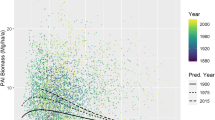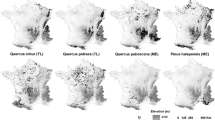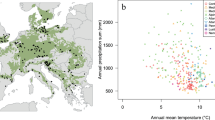Abstract
National Forest Inventories (NFIs) perform systematic forest surveys across space and time. They are hence powerful tools to understand climate controls on forest growth at wide geographical scales and account for the effects of local abiotic and biotic interactions. To investigate the effects of climate change upon growth dynamics of four major European conifer species along elevation and continentality gradients, we herein provide an original harmonization of the French and Austrian NFI datasets. The growth of Norway spruce, Scots pine, silver fir and European larch over the 1996–2016 period was studied in pure and even-aged plots across different ecological regions. We derived climate-driven growth trends from > 65, 000 radial increment series filtered out from major biotic and abiotic influences using statistical modeling. We further identified primary environmental drivers of conifer growth by regressing growth trends against regionally aggregated biotic and abiotic forest attributes. Negative growth trends were observed in continental regions undergoing the most rapid warming and thermal amplitude contraction over the study period. Negative trends were also associated with lower forest structural heterogeneity and, surprisingly, with greater available water capacity. Remarkably, we observed these associations both at the inter- and intra-species levels, suggesting the universality of these primary growth determinants. Our study shows that harmonized NFI data at the transnational level provide reliable information on climate–growth interactions. Here, greater forest structural complexity and greater water resource limitation were highlighted as drivers of greater forest resilience to climate change at large-scale. This result forms crucial bases to implementing climate-smart forest management.






Similar content being viewed by others
References
Alberdi I, Gschwantner T, Bosela M, Redmond J, Riedel T, Snorrason A, Gasparini P, Brändli U-B, Fridman J, Tomter S, Kulbokas G, Lanz A, Vidal C. 2016. Harmonisation of data and information on the potential supply of wood resources. In: National Forest Inventories. Springer, Cham. Vidal C., Alberdi I., Hernandez Mateo L., Redmond J. (eds). pp pp55–79. https://doi.org/10.1007/978-3-319-44015-6_3
Andersson FA. 2005. Ecosystems of the world - Coniferous forests. Netherlands: Elsevier Science.
Anon. 2021. Forests - new EU strategy. https://ec.europa.eu/info/law/better-regulation/have-your-say/initiatives/12674-Forests-new-EU-strategy/public-consultation
Babst F, Bouriaud O, Poulter B, Trouet V, Girardin MP, Frank DC. 2019. Twentieth century redistribution in climatic drivers of global tree growth. Science Advances 5:eaat4313.
Bontemps J-D, Hervé J-C, Dhôte J-F. 2010. Dominant radial and height growth reveal comparable historical variations for common beech in north-eastern France. Forest Ecology and Management 259:1455–63. https://www.sciencedirect.com/science/article/pii/S0378112710000253
Bose AK, Gessler A, Bolte A, Bottero A, Buras A, Cailleret M, Camarero JJ, Haeni M, Hereş A-M, Hevia A, Lévesque M, Linares JC, Martinez-Vilalta J, Matías L, Menzel A, Sánchez-Salguero R, Saurer M, Vennetier M, Ziche D, Rigling A. 2020. Growth and resilience responses of Scots pine to extreme droughts across Europe depend on predrought growth conditions. Global Change Biology 26:4521–4537. https://doi.org/10.1111/gcb.15153.Lastaccessed04/03/2021.
Bosela M, Tumajer J, Cienciala E, Dobor L, Kulla L, Marčiš P, Popa I, Sedmák R, Sedmáková D, Sitko R, Šebeň V, Štěpánek P, Büntgen U. 2021. Climate warming induced synchronous growth decline in Norway spruce populations across biogeographical gradients since 2000. Science of The Total Environment 752:141794. http://www.sciencedirect.com/science/article/pii/S0048969720353237
Box GEP, Cox DR. 1964. An Analysis of Transformations. Journal of the Royal Statistical Society: Series B (methodological) 26:211–243. https://doi.org/10.1111/j.2517-6161.1964.tb00553.x.Lastaccessed23/09/2019.
Brang P, Spathelf P, Larsen JB, Bauhus J, Boncčìna A, Chauvin C, Drössler L, García-Güemes C, Heiri C, Kerr G, Lexer MJ, Mason B, Mohren F, Mühlethaler U, Nocentini S, Svoboda M. 2014. Suitability of close-to-nature silviculture for adapting temperate European forests to climate change. Forestry: An International Journal of Forest Research 87:492–503. https://doi.org/10.1093/forestry/cpu018. Last accessed 21/02/2020
Buras A, Rammig A, Zang CS. 2019. Quantifying impacts of the drought 2018 on European ecosystems in comparison to 2003. Biogeosciences Discuss 2019:1–23. https://www.biogeosciences-discuss.net/bg-2019-286/
Cavaignac S. 2009. Les sylvoécorégions (SER) de France métropolitaine. Etude de définition. Inventaire Forestier National, Nogent-sur-Vernisson
Charru M, Seynave I, Hervé J-C, Bertrand R, Bontemps J-D. 2017. Recent growth changes in Western European forests are driven by climate warming and structured across tree species climatic habitats. Annals of Forest Science 74:33.
Charru M, Seynave I, Hervé J-C, Bontemps J-D. 2014. Spatial patterns of historical growth changes in Norway spruce across western European mountains and the key effect of climate warming. Trees 28:205–221. https://doi.org/10.1007/s00468-013-0943-4.
Contosta AR, Adolph A, Burchsted D, Burakowski E, Green M, Guerra D, Albert M, Dibb J, Martin M, McDowell WH, Routhier M, Wake C, Whitaker R, Wollheim W. 2017. A longer vernal window: the role of winter coldness and snowpack in driving spring transitions and lags. Glob Change Biol 23:1610–1625.
Cornes RC, van der Schrier G, van den Besselaar EJM, Jones PD. 2018. An Ensemble Version of the E-OBS Temperature and Precipitation Data Sets. Journal of Geophysical Research: Atmospheres 123:9391–9409. https://doi.org/10.1029/2017JD028200.Lastaccessed23/09/2019.
D’Amato AW, Bradford JB, Fraver S, Palik BJ. 2011. Forest management for mitigation and adaptation to climate change: Insights from long-term silviculture experiments. Forest Ecology and Management 262:803–16. http://www.sciencedirect.com/science/article/pii/S0378112711002775
Davis KT, Dobrowski SZ, Holden ZA, Higuera PE, Abatzoglou JT. 2019. Microclimatic buffering in forests of the future: the role of local water balance. Ecography 42:1–11. https://doi.org/10.1111/ecog.03836.Lastaccessed23/09/2019.
DeRose RJ, Shaw JD, Long JN. 2017. Building the Forest Inventory and Analysis Tree-Ring Data Set. Journal of Forestry 115:283–291. https://doi.org/10.5849/jof.15-097.Lastaccessed29/10/2019.
Dunson WA, Travis J. 1991. The Role of Abiotic Factors in Community Organization. The American Naturalist 138:1067–91. http://www.jstor.org/stable/2462508
Dymond CC, Tedder S, Spittlehouse DL, Raymer B, Hopkins K, McCallion K, Sandland J. 2014. Diversifying managed forests to increase resilience. Can J for Res 44:1196–1205. https://doi.org/10.1139/cjfr-2014-0146.Lastaccessed11/06/2020.
Enderle R, Stenlid J, Vasaitis R. 2019. An overview of ash (Fraxinus spp.) and the ash dieback disease in Europe.
Fox J, Weisberg S. 2019. An R Companion to Applied Regression. http://z.umn.edu/carbook
Gini C. 1912. Variabilità e Mutuabilità. Contributo allo Studio delle Distribuzioni e delle Relazioni Statistiche. Tipografia di Paolo Cuppini. Bologna
Girardin MP, Hogg EH, Bernier PY, Kurz WA, Guo XJ, Cyr G. 2016. Negative impacts of high temperatures on growth of black spruce forests intensify with the anticipated climate warming. Glob Chang Biol 22:627–643.
Giuggiola A, Ogée J, Rigling A, Gessler A, Bugmann H, Treydte K. 2016. Improvement of water and light availability after thinning at a xeric site: which matters more? A dual isotope approach. New Phytologist 210:108–121. https://doi.org/10.1111/nph.13748.Lastaccessed04/03/2021.
Gschwantner T. 2006. Growth changes from the Austrian forest inventory data and their climatic causes.
Gschwantner T, Berger A, Büchsenmeister R, Hauk E. 2016a. National Forest Inventories Reports - Austria. In: National Forest Invetories - Assessment of Wood Availability and Use. Springer International Publishing Switzerland. Vidal et al. p XXXII, 845.
Gschwantner T, Lanz A, Vidal C, Bosela M, Di Cosmo L, Fridman J, Gasparini P, Kuliešis A, Tomter S, Schadauer K. 2016. Comparison of methods used in European National Forest Inventories for the estimation of volume increment: towards harmonisation. Annals of Forest Science 73:807–821. https://doi.org/10.1007/s13595-016-0554-5.
Guillemot J, Delpierre N, Vallet P, François C, Martin-StPaul NK, Soudani K, Nicolas M, Badeau V, Dufrêne E. 2014. Assessing the effects of management on forest growth across France: insights from a new functional–structural model. Annals of Botany 114:779–793. https://doi.org/10.1093/aob/mcu059.Lastaccessed19/02/2021.
Hartl-Meier C, Dittmar C, Zang C, Rothe A. 2014. Mountain forest growth response to climate change in the Northern Limestone Alps. Trees 28:819–829. https://doi.org/10.1007/s00468-014-0994-1.
Hember RA, Kurz WA, Coops NC. 2016. Relationships between individual-tree mortality and water-balance variables indicate positive trends in water stress-induced tree mortality across North America. Glob Chang Biol:n/a-n/a.
Hervé J-C. 2016. National Forest Inventories Reports - France. In: National Forest Inventories - Assessment of Wood Availability and Use. Springer International Publishing Switzerland. Vidal et al. p XXXII, 845.
Jeong S-J, Ho C-H, Gim H-J, Brown ME. 2011. Phenology shifts at start vs. end of growing season in temperate vegetation over the Northern Hemisphere for the period 1982–2008. Glob Chang Biol 17:2385–2399.
Johansson OV. 1926. Uber die Asymmetrie der meteorologischen Schwankungen. Societas Scientiarum Fennica Commentationes Physico-Mathematicae 3.
Kauppi PE, Posch M, Pirinen P. 2014. Large Impacts of Climatic Warming on Growth of Boreal Forests since 1960. PLOS ONE 9:e111340. https://doi.org/10.1371/journal.pone.0111340.
Killian W, Müller F, Starlinger F. 1994. Die forstlichen Wuchsgebiete Österreichs. Eine Naturraumgliederung nach waldökologischen Gesichtspunken. Schriftenreihe der Forstlichen Bundesversuchsanstalt Wien
Kindermann G. 2009. Herleitung des jährlichen Zuwachses für Bäume deren BHD-Zuwachs nur für einen längeren Zeitraum bekannt ist. DVFFA – Sektion Ertragskunde:182–90. http://sektionertragskunde.fvabw.de/band2009/Tag2009_21.pdf
Klesse S, DeRose RJ, Guiterman CH, Lynch AM, O’Connor CD, Shaw JD, Evans MEK. 2018. Sampling bias overestimates climate change impacts on forest growth in the southwestern United States. Nature Communications 9:5336.
Lafond V, Lagarrigues G, Cordonnier T, Courbaud B. 2014. Uneven-aged management options to promote forest resilience for climate change adaptation: effects of group selection and harvesting intensity. Annals of Forest Science 71:173–186. https://doi.org/10.1007/s13595-013-0291-y.
Lebourgeois F, Eberlé P, Mérian P, Seynave I. 2014. Social status-mediated tree-ring responses to climate of Abies alba and Fagus sylvatica shift in importance with increasing stand basal area. Forest Ecology and Management 328:209–18. https://www.sciencedirect.com/science/article/pii/S0378112714003442
Levers C, Verkerk PJ, Müller D, Verburg PH, Butsic V, Leitão PJ, Lindner M, Kuemmerle T. 2014. Drivers of forest harvesting intensity patterns in Europe. Forest Ecology and Management 315:160–72. http://www.sciencedirect.com/science/article/pii/S0378112713008335
Linder M. 2000. Developing adaptive forest management strategies to cope with climate change. Tree Physiology 20:299–307. https://doi.org/10.1093/treephys/20.5-6.299.Lastaccessed06/11/2020.
McRoberts RE, Tomppo E, Schadauer K, Vidal C, Ståhl G, Chirici G, Lanz A, Cienciala E, Winter S, Smith WB. 2009. Harmonizing National Forest Inventories. Journal of Forestry 107:179–187. https://doi.org/10.1093/jof/107.4.179.Lastaccessed14/09/2020.
Menzel A, Sparks TH, Estrella N, Koch E, Aasa A, Ahas R, Alm-Kübler K, Bissolli P, Braslavská O, Briede A, Chmielewski FM, Crepinsek Z, Curnel Y, Dahl Å, Defila C, Donnelly A, Filella Y, Jatczak K, Måge F, Mestre A, Nordli Ø, PeÑuelas J, Pirinen P, RemiŠová V, Scheifinger H, Striz M, Susnik A, Van Vliet AJH, Wielgolaski F-E, Zach S, Zust ANA. 2006. European phenological response to climate change matches the warming pattern. Glob Chang Biol 12:1969–1976.
Mérian P, Pierrat J-C, Lebourgeois F. 2013. Effect of sampling effort on the regional chronology statistics and climate–growth relationships estimation. Dendrochronologia 31:58–67. http://www.sciencedirect.com/science/article/pii/S1125786512000628
Nehrbass-Ahles C, Babst F, Klesse S, Notzli M, Bouriaud O, Neukom R, Dobbertin M, Frank D. 2014. The influence of sampling design on tree-ring-based quantification of forest growth. Global Change Biol 20:2867–2885.
Oberhuber W. 2004. Influence of climate on radial growth of Pinus cembra within the alpine timberline ecotone. Tree Physiology 24:291–301. https://doi.org/10.1093/treephys/24.3.291.Lastaccessed10/05/2020.
Ols C, Bontemps J-D. 2021. Pure and even-aged forestry of fast-growing conifers under climate change: on the need for a silvicultural paradigm shift. Environmental Research Letters 16:024030. https://doi.org/10.1088/1748-9326/abd6a7.
Ols C, Hervé J-C, Bontemps J-D. 2020. Recent growth trends of conifers across Western Europe are controlled by thermal and water constraints and favored by forest heterogeneity. Science of The Total Environment 742:140453. http://www.sciencedirect.com/science/article/pii/S0048969720339759
Ponocná T, Spyt B, Kaczka R, Büntgen U, Treml V. 2016. Growth trends and climate responses of Norway spruce along elevational gradients in East-Central Europe. Trees 30:1633–1646. https://doi.org/10.1007/s00468-016-1396-3.
R Core Team. 2015. R: A language and environment for statistical computing. R Foundation for Statistical Computing, Vienna, Austria IURL http://wwwR-project.org/.
Reineke LH. 1933. Perfecting a stand-density index for even-aged forests. Journal of Agricultural Research 46:627–638.
Rozenberg P, Chauvin T, Escobar-Sandoval M, Huard F, Shishov V, Charpentier J-P, Sergent A-S, Vargas-Hernandez JJ, Martinez-Meier A, Pâques L. 2020. Climate warming differently affects Larix decidua ring formation at each end of a French Alps elevational gradient. Annals of Forest Science 77:54. https://doi.org/10.1007/s13595-020-00958-w.
Rubio-Cuadrado Á, Camarero JJ, Gordaliza GG, Cerioni M, Montes F, Gil L. 2020. Competition overrides climate as trigger of growth decline in a mixed Fagaceae Mediterranean rear-edge forest. Annals of Forest Science 77:94. https://doi.org/10.1007/s13595-020-01004-5.
Sánchez-Salguero R, Linares JC, Camarero JJ, Madrigal-González J, Hevia A, Sánchez-Miranda Á, Ballesteros-Cánovas JA, Alfaro-Sánchez R, García-Cervigón AI, Bigler C, Rigling A. 2015. Disentangling the effects of competition and climate on individual tree growth: A retrospective and dynamic approach in Scots pine. Forest Ecology and Management 358:12–25. http://www.sciencedirect.com/science/article/pii/S0378112715004661
Savill P, Evans J, Auclair D, Falck J. 1997. Plantation Silviculture in Europe. Oxford University Press.
Sedjo RA. 2001. The role of forest plantations in the world’s future timber supply. The Forestry Chronicle 77:221–225. https://doi.org/10.5558/tfc77221-2.Lastaccessed10/06/2020.
Seynave I, Bailly A, Balandier P, Bontemps J-D, Cailly P, Cordonnier T, Deleuze C, Dhôte J-F, Ginisty C, Lebourgeois F, Merzeau D, Paillassa E, Perret S, Richter C, Meredieu C. 2018. GIS Coop: networks of silvicultural trials for supporting forest management under changing environment. Annals of Forest Science 75:48. https://doi.org/10.1007/s13595-018-0692-z.
Shestakova TA, Gutierrez E, Kirdyanov AV, Camarero JJ, Genova M, Knorre AA, Linares JC, Resco de Dios V, Sanchez-Salguero R, Voltas J. 2016. Forests synchronize their growth in contrasting Eurasian regions in response to climate warming. Proceedings of the National Academy of Sciences of the United States of America 113:662–667.
Smith WB, Cuenca Lara RA, Delgado Caballero CE, Godínez Valdivia CI, Kapron JS, Leyva Reyes JC, Meneses Tovar CL, Miles PD, Oswalt SN, Ramírez Salgado M, Song XA, Stinson G, Villela Gaytán SA. 2018. The North American Forest Database: going beyond national-level forest resource assessment statistics. Environmental Monitoring and Assessment 190:350. https://doi.org/10.1007/s10661-018-6649-8.
Smith WK, Hinckley TM, editors. 1995. Physiological Ecology: A Series of Monographs, Texts, and Treatises. In: Ecophysiology of Coniferous Forests. San Diego: Academic Press. pp ifc1–2. http://www.sciencedirect.com/science/article/pii/B9780080925936500013
Sohn JA, Kohler M, Gessler A, Bauhus J. 2012. Interactions of thinning and stem height on the drought response of radial stem growth and isotopic composition of Norway spruce (Picea abies). Tree Physiology 32:1199–1213. https://doi.org/10.1093/treephys/tps077.Lastaccessed03/04/2021.
Tomppo E, Gschwantner T, Lawrence M, McRoberts RE. 2010. National Forest Inventories - Pathways for Common Reporting, 1st edn. Netherlands: Springer.
Tomppo EO, Schadauer K. 2012. Harmonization of National Forest Inventories in Europe: Advances under COST Action E43. Forest Science 58:191–200. https://doi.org/10.5849/forsci.10-091.Lastaccessed21/10/2020.
Trouvé R, Bontemps J-D, Collet C, Seynave I, Lebourgeois F. 2017. Radial growth resilience of sessile oak after drought is affected by site water status, stand density, and social status. Trees 31:517–529. https://doi.org/10.1007/s00468-016-1479-1.
Vidal C, Alberdi I, Hernandez L, Redmond J. 2016. National Forest Inventories - Assessment of Wood Availability and Use. 1st ed. Springer International Publishing Switzerland
Vospernik S, Nothdurft A. 2018. Can trees at high elevations compensate for growth reductions at low elevations due to climate warming? Can J for Res 48:650–662. https://doi.org/10.1139/cjfr-2017-0326.Lastaccessed17/09/2020.
Weber N. 1998. Afforestation in Europe: Experiences and Future Possibilities. In: Carbon Dioxide Mitigation in Forestry and Wood Industry. Springer, Berlin, Heidelberg.
Weil RR, Brady NC. 2016. The nature and properties of soils. 15th ed. Pearson
Wu C, Hember RA, Chen JM, Kurz WA, Price DT, Boisvenue C, Gonsamo A, Ju W. 2014. Accelerating Forest Growth Enhancement due to Climate and Atmospheric Changes in British Colombia, Canada over 1956–2001. Scientific Reports 4:4461. https://doi.org/10.1038/srep04461.
Wykoff WR. 1990. A Basal Area Increment Model for Individual Conifers in the Northern Rocky Mountains. Forest Science 36:1077–1104. https://doi.org/10.1093/forestscience/36.4.1077.Lastaccessed06/12/2020.
Acknowledgements
This study was funded by the French National Research Agency (ANR) through the ‘Laboratoire d’Excellence ARBRE’ and the PIA ‘Lorraine Université d’Excellence’ projects (ANR-11-LABX-0002-01 and ANR-15-IDEX-04-LUE) and by the Région Grand Est through a fellowship “Soutien aux jeunes chercheurs” (18_GE5_029). We acknowledge the E-OBS dataset from the EU-FP6 project UERRA (http://www.uerra.eu) and the Copernicus Climate Change Service, and the data providers in the ECA&D project (https://www.ecad.eu). We are thankful to Francois Morneau for help regarding the extraction of the French NFI data, Ingrid Seynave and Emilien Kunz for the extraction of ground-flora based soil variables and Emeline Chaste for help regarding the extraction of netcdf climate data. We want to thank Georg Kindermann for providing annualized diameter data for Austria and familiarization with the interpolation algorithm. We also acknowledge support from Karl Gartner, Edwin Herzberger and Rainer Reiter from the Department of Forest Ecology and Soils at BFW for the extraction and computation of Austrian soil variables. Finally, we would like to thank the subject-matter editor and the two anonymous reviewers for their thoughtful feedback on this manuscript.
Author information
Authors and Affiliations
Corresponding author
Ethics declarations
Conflict of interest
The authors declare no conflict of interest.
Additional information
Author’s Contributions: JDB with the help of TG and KS conceived or designed the study; CO with the help of JDB and TG performed the research; CO analyzed the data; JDB and CO contributed new methods or models; and CO with the help of JDB, TG and KS wrote the paper.
Supplementary Information
Below is the link to the electronic supplementary material.
Rights and permissions
About this article
Cite this article
Ols, C., Gschwantner, T., Schadauer, K. et al. Unexpected Negative Effect of Available Water Capacity Detected on Recent Conifer Forest Growth Trends Across Wide Environmental Gradients. Ecosystems 25, 404–421 (2022). https://doi.org/10.1007/s10021-021-00663-3
Received:
Accepted:
Published:
Issue Date:
DOI: https://doi.org/10.1007/s10021-021-00663-3




